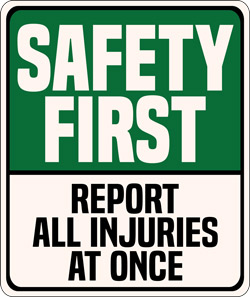Just like clockwork, the start of a new year brings two important Occupational Safety and Health Administration (OSHA) recordkeeping requirements that printing operations must be aware of and comply with if they qualify. They involve the completion, posting, and submission of certain separate, but related, recordkeeping forms.
Meeting these requirements is especially important this year with the change in administrations, which will bring a renewed focus on OSHA compliance. The Biden Administration has made increasing OSHA rule-making and enforcement a priority and companies can expect to see more inspections and scrutiny. While COVID-19 will slow down the enforcement ramp-up, by the end of the year, OSHA will be in full operation. This means printing operations need to be diligent in meeting their obligations.
 Throughout the calendar year, OSHA requires companies with more than 10 full-, part-time, or temporary employees to complete and maintain Form 300, known as the Log of Work-Related Injuries and Illnesses. This is to be completed for each work-related recordable injury and illness or fatality occurring in the workplace. For injuries, any incident resulting in medical treatment beyond first aid constitutes a recordable incident and must be entered in Form 300. OSHA has a specific list of first-aid activities that needs to be reviewed prior to entering an injury as any injury only requiring first aid does not have to be recorded.
Throughout the calendar year, OSHA requires companies with more than 10 full-, part-time, or temporary employees to complete and maintain Form 300, known as the Log of Work-Related Injuries and Illnesses. This is to be completed for each work-related recordable injury and illness or fatality occurring in the workplace. For injuries, any incident resulting in medical treatment beyond first aid constitutes a recordable incident and must be entered in Form 300. OSHA has a specific list of first-aid activities that needs to be reviewed prior to entering an injury as any injury only requiring first aid does not have to be recorded.At the end of each year, all Form 300 entries are to be totaled and the summary of the information is to be recorded on Form 300A, known as the Summary of Work-Related Injuries & Illnesses. In addition to the summation of the workplace injuries and illnesses recorded during the previous calendar year, Form 300A must include the total hours worked that year by all employees covered by OSHA Form 300.
Once completed, Form 300A must be “certified” with the signature of a responsible company official (e.g., owner, officer of the company, or highest-ranking company official at the establishment) and posted no later than Feb. 1 in a conspicuous place where employee notices are customarily posted. It must remain posted through April 30.
OSHA's second reporting requirement is that every printing operation that has, or had at any time last year, more than 20 full-, part-time, or temporary employees must electronically submit their Form 300A data by March 2.
To allow employers to accept this data, OSHA created the Injury Tracking Application (ITA). The web-based form allows employers to electronically submit required injury and illness data from their completed 2019 OSHA Form 300A. The application is accessible at the ITA webpage.
The secure website offers three options for data submission. One enables users to manually enter data into a web form, while another allows for uploading a CSV file to process single or multiple establishments simultaneously. The third option enables companies using automated record-keeping systems to transmit data electronically via an application programming interface.
Always keep copies of your electronic correspondence from OSHA to demonstrate that you have met the new reporting requirement.
Another Important Deadline
In addition to these mandatory OSHA deadlines, don't forget to sign up for PRINTING United Alliance's 2021 Safety Recognition Program. The Alliance’s Government Affairs Department offers many resources, such as written program templates, to assist printing operations in addressing their compliance programs. Please contact govtaffairs@printing.org for assistance, and if you missed last week's post on the top 10 OSHA workplace violations for printers last week, you can read it here.
In doing so, Jones works closely with the federal and state-level Environmental Protection Agencies, Occupational Safety and Health Agency, Department of Transportation, and other agencies. He also provides membership assistance on EHS compliance and sustainability programs.